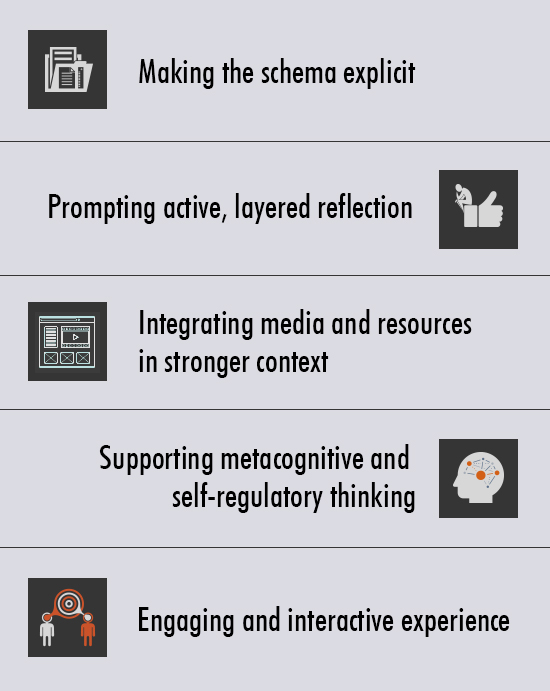(If you’re new to this series, here is some brief background to help you catch up:
Given the unique training challenges that the COVID-19 pandemic poses for us all, this series explores the various considerations for delivering an effective VILT (Virtual Instructor-Led Training). I recommend that you read the first five posts in sequence, and then, you can even pick and choose what’s of greater relevance to you.
We had previously talked about the use of stylus writing devices for conducting a VILT. This kind of content presentation gives you the ability to dynamically structure content based on the session flow, audience response, and knowledge level. So, it’s worth considering equally flexible content structuring methods. Now there are so many ways possible, but keeping in mind that aspect of flexibility in particular, the one I’d like to discuss today is the use of concept maps.
The effectiveness of concept maps in learning and teaching has been borne out by any number of studies by now. A concept map is superior to conventional presentation decks in especially 2 striking aspects:
- It is non-linear
- It can contain any level of depth, even unevenly distributed curricular depth
- All the information can be seen at a glance (okay, so there are 3 striking aspects!)
But a concept map does more than simply ‘beat a slide deck’ – it is a powerful tool in its own right, and has a particular value in teaching. Let’s explore some of those reasons, shall we?


We create webs of knowledge. Deep learning requires that we construct such structure (or schema) when we learn, rather than try to have a floating, disconnected set of facts. The more closely we can connect a new web with our pre-existing webs, the more likely we are to retain the new information, integrate it with what we already know, see interconnections, and be able to understand it in various useful contexts. On a good day and without the unique challenges posed by a VILT, this is a tall order. In a VILT, it just makes sense to stack the odds in our favor!
Further, considering that we are likely to need more frequent breaks during VILTs, a visual structuring of content in this manner will help sustain continuity and connection in the learning episodes. Learners will be able to literally see where they are in the curriculum and why they are learning something.

The aspect of being able to see the structure of the content and the entire curriculum laid out visually, means that learners can observe the depth of their knowledge about a topic. They can maintain this clarity even in the middle of drilling down several levels in a complex topic. The visual support to maintain that ‘bird’s eye view’ simultaneously alongside the ‘ant’s view’ is a major boost for learning retention and future recall.
In the VILT, the facilitator can also carve out a section of the map to include concerns of application, integration into existing organizational processes, etc. to capture, integrate, and reflect employees’ concerns and performance contexts more strongly in the training. This will have a significant effect on the ability and readiness of learners to actually apply what they learn.

In particularly large organizations, courses can often be resource-rich, offering relevant organizational policies, SOPs, guidelines, forms, templates, etc. Like any encyclopedic repository, this is a double-edged sword: learners can feel like they have everything they could need to be able to meet the training outcomes or just as easily feel overwhelmed under the information overload. Remember, all of that repository material is after all in addition to the primary course material!
One of the wonderful things about a concept map is that it forces the creator to always link every node created to the rest of the structure. Learners are protected from the “the SME says you should know this” school of curriculum dumping, and instead get to know every element of the training, why it is included in the training, and how it connects to everything else. (No more random roleplays and vague talking head videos that leave you unsure of why on earth you must pay them any heed.)
In a VILT, where brevity and high-value are the main requirements of the design, this is a very healthy constraint/discipline for facilitators to embrace!

The sort of thinking we discussed when exploring the benefits of making the schema explicit and prompting active, layered reflection are a big part of metacognition. These ways of reflecting on our thought processes as we learn, help to regulate our learning behaviors and mental processes. As a result, we build not only a knowing of the subject, but also of our level of understanding, gaps in our understanding, the degree of connectedness with other things we know, etc.
This kind of behind-the-scenes knowledge of our minds as we learn is a critical component of the foundation that we need to eventually build for expertise. In a VILT, given the synchronous nature of the session, the facilitator can actively support and cue learners to do this.

As you can see from the ways that a VILT facilitator can interact with learners, a concept map becomes all three — curriculum, methodology, and agenda — for the session. It guides the facilitator to offer a richer learning experience.
Learners have a better sense of the flow of the session, are able to anticipate information and relate to it better. And so, whether they are conscious of all the manner of scaffolding or not, they are more engaged with the session.
Since we’ve talked extensively about mind mapping this time, I have a confession… At Upside Learning, we love our concept mapping! In fact, we have a custom, proprietary, fully responsive concept mapping framework so that you can even deliver eLearning in this manner, on all devices. With the foundation of this powerful framework, we can easily customize it to also be a valuable VILT teaching tool for your organization.
The Upside Learning mind map framework bagged Brandon Hall and LearnX Award as soon as it was launched! Why? Because it stands out from every other concept map software available, in that it supports not only concept mapping of your entire course content, but also the learning exercises and scaffolding interactivities that are essential for a robust, self-paced learning experience. Just contact us for a one-on-one demo, and we’ll be thrilled to show off our brainchild.
Looking to Go Virtual?
Talk to our Digital Learning Experts to understand how can we help you transform your ILTs to Digital Learning quickly and on a budget. Or write to us at elearning@upsidelearning.com



















